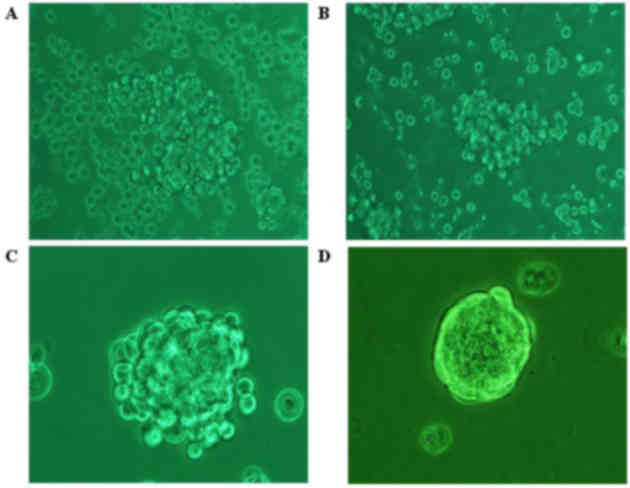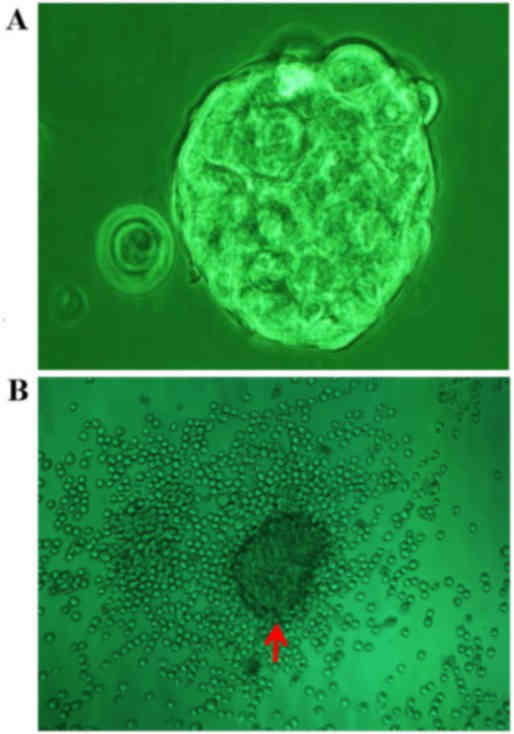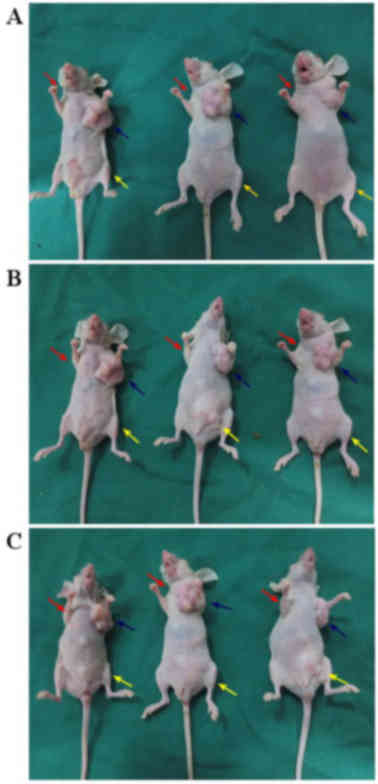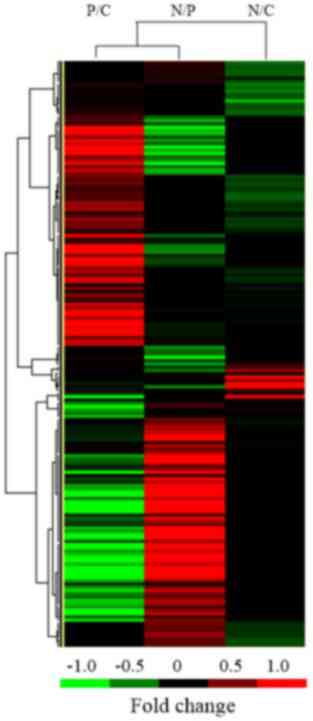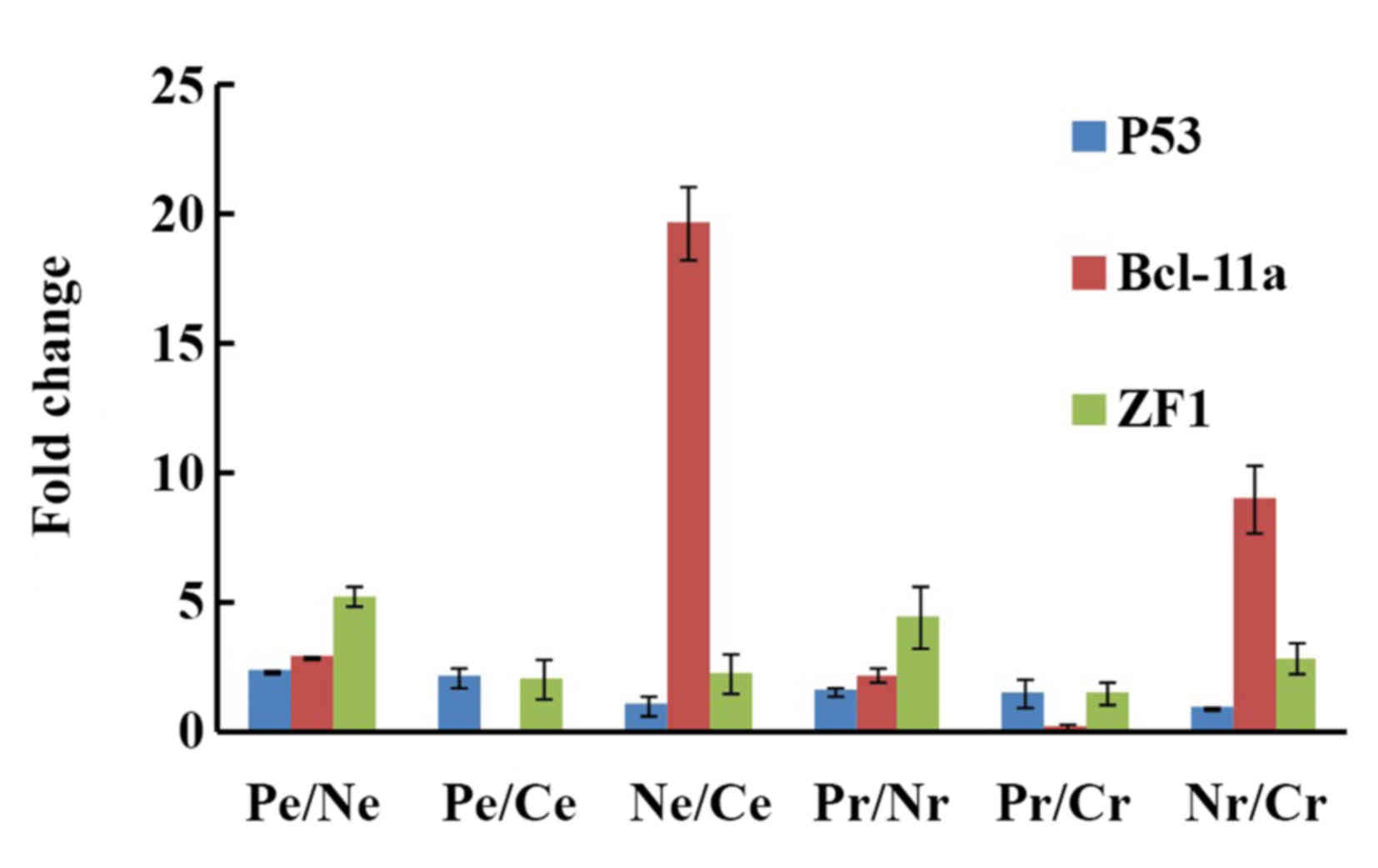|
1
|
Zhou BB and Elledge SJ: The DNA damage
response: Putting checkpoints in perspective. Nature. 408:433–439.
2000. View Article : Google Scholar : PubMed/NCBI
|
|
2
|
Gasser S and Raulet D: The DNA damage
response, immunity and cancer. Semin Cancer Biol. 16:344–347. 2006.
View Article : Google Scholar : PubMed/NCBI
|
|
3
|
Mallette FA and Ferbeyre G: The DNA damage
signaling pathway connects oncogenic stress to cellular senescence.
Cell Cycle. 6:1831–1836. 2007. View Article : Google Scholar : PubMed/NCBI
|
|
4
|
Liang Y, Lin SY, Brunicardi FC, Goss J and
Li K: DNA damage response pathways in tumor suppression and cancer
treatment. World J Surg. 33:661–666. 2009. View Article : Google Scholar : PubMed/NCBI
|
|
5
|
Morgan MA and Lawrence TS: Molecular
pathways: Overcoming radiation resistance by targeting DNA damage
response pathways. Clin Cancer Res. 21:2898–2904. 2015. View Article : Google Scholar : PubMed/NCBI
|
|
6
|
Shimizu I, Yoshida Y, Suda M and Minamino
T: DNA damage response and metabolic disease. Cell Metab.
20:967–977. 2014. View Article : Google Scholar : PubMed/NCBI
|
|
7
|
Rajewsky MF, Engelbergs J, Thomale J and
Schweer T: DNA repair: Counteragent in mutagenesis and
carcinogenesis- accomplice in cancer therapy resistance. Mutat Res.
462:101–105. 2000. View Article : Google Scholar : PubMed/NCBI
|
|
8
|
Goldstein M and Kastan MB: The DNA damage
response: Implications for tumor responses to radiation and
chemotherapy. Annu Rev Med. 66:129–143. 2015. View Article : Google Scholar : PubMed/NCBI
|
|
9
|
Annovazzi L, Caldera V, Mellai M, Riganti
C, Battaglia L, Chirio D, Melcarne A and Schiffer D: The DNA
damage/repair cascade in glioblastoma cell lines after
chemotherapeutic agent treatment. Int J Oncol. 46:2299–2308.
2015.PubMed/NCBI
|
|
10
|
Paull TT: Mechanisms of ATM activation.
Annu Rev Biochem. 84:711–738. 2015. View Article : Google Scholar : PubMed/NCBI
|
|
11
|
Suvorova II, Kozhukharova IV, Nikol'skiĭ
NN and Pospelov VA: ATM/ATR signaling pathway activation in human
embryonic stem cells after DNA damage. Tsitologiia. 55:841–851.
2013.(In Russian). PubMed/NCBI
|
|
12
|
Kühne C, Tjörnhammar ML, Pongor S, Banks L
and Simoncsits A: Repair of a minimal DNA double-strand break by
NHEJ requires DNA-PKcs and is controlled by the ATM/ATR checkpoint.
Nucleic Acids Res. 31:7227–7737. 2003. View Article : Google Scholar : PubMed/NCBI
|
|
13
|
Knittel G, Liedgens P and Reinhardt HC:
Targeting ATM-deficient CLL through interference with DNA repair
pathways. Front Genet. 6:2072015. View Article : Google Scholar : PubMed/NCBI
|
|
14
|
Nakazawa K, Dashzeveg N and Yoshida K:
Tumor suppressor p53 induces miR-1915 processing to inhibit Bcl-2
in the apoptotic response to DNA damage. FEBS J. 281:2937–2944.
2014. View Article : Google Scholar : PubMed/NCBI
|
|
15
|
Mlynarczyk C and Fåhraeus R: Endoplasmic
reticulum stress sensitizes cells to DNA damage-induced apoptosis
through p53-dependent suppression of p21 (CDKN1A). Nat Commun.
5:50672014. View Article : Google Scholar : PubMed/NCBI
|
|
16
|
Yajima N, Wada R, Matsuzaki Y and
Yagihashi S: DNA damage response and its clinicopathological
relationship in appendiceal tumors. Int J Colorectal Dis.
29:1349–1354. 2014. View Article : Google Scholar : PubMed/NCBI
|
|
17
|
Sun T and Cui J: A plausible model for
bimodal p53 switch in DNA damage response. FEBS Lett. 588:815–821.
2014. View Article : Google Scholar : PubMed/NCBI
|
|
18
|
Broustas CG and Lieberman HB: DNA damage
response genes and the development of cancer metastasis. Radiat
Res. 181:111–130. 2014. View Article : Google Scholar : PubMed/NCBI
|
|
19
|
Hosoya N and Miyagawa K: Targeting DNA
damage response in cancer therapy. Cancer Sci. 105:370–388. 2014.
View Article : Google Scholar : PubMed/NCBI
|
|
20
|
Kelley MR, Logsdon D and Fishel ML:
Targeting DNA repair pathways for cancer treatment: what's new?
Future Oncol. 10:1215–1237. 2014. View Article : Google Scholar : PubMed/NCBI
|
|
21
|
Khanna A: DNA damage in cancer
therapeutics: A boon or a curse? Cancer Res. 75:2133–2138. 2015.
View Article : Google Scholar : PubMed/NCBI
|
|
22
|
Korwek Z and Alster O: The role of the DNA
damage response in apoptosis and cell senescence. Postepy Biochem.
60:248–262. 2014.(In Polish). PubMed/NCBI
|
|
23
|
Prakash A and Doublié S: Base excision
repair in the mitochondria. J Cell Biochem. 116:1490–1499. 2015.
View Article : Google Scholar : PubMed/NCBI
|
|
24
|
Tian H, Gao Z, Li H, Zhang B, Wang G,
Zhang Q, Pei D and Zheng J: DNA damage response-a double-edged
sword in cancer prevention and cancer therapy. Cancer Lett.
358:8–16. 2015. View Article : Google Scholar : PubMed/NCBI
|
|
25
|
Wallace NA and Galloway DA: Manipulation
of cellular DNA damage repair machinery facilitates propagation of
human papillomaviruses. Semin Cancer Biol. 26:30–42. 2014.
View Article : Google Scholar : PubMed/NCBI
|
|
26
|
Zhou L, Wei X, Cheng L, Tian J and Jiang
JJ: CD133, one of the markers of cancer stem cells in Hep-2 cell
line. Laryngoscope. 117:455–460. 2007. View Article : Google Scholar : PubMed/NCBI
|
|
27
|
Gussin HA, Sharma AK and Elias S: Culture
of endothelial cells isolated from maternal blood using anti-CD105
and CD133. Prenat Diagn. 24:189–193. 2004. View Article : Google Scholar : PubMed/NCBI
|
|
28
|
Yu SC, Ping YF, Yi L, Zhou ZH, Chen JH,
Yao XH, Gao L, Wang JM and Bian XW: Isolation and characterization
of cancer stem cells from a human glioblastoma cell line U87.
Cancer Lett. 265:124–134. 2008. View Article : Google Scholar : PubMed/NCBI
|
|
29
|
Li HZ, Yi TB and Wu ZY: Suspension culture
combined with chemotherapeutic agents for sorting of breast cancer
stem cells. BMC Cancer. 8:1352008. View Article : Google Scholar : PubMed/NCBI
|
|
30
|
Ballester M, Castelló A, Ibáñez E, Sánchez
A and Folch JM: Real-time quantitative PCR-based system for
determining transgene copy number in transgenic animals.
Biotechniques. 37:610–613. 2004.PubMed/NCBI
|
|
31
|
Krokan HE and Bjørås M: Base excision
repair. Cold Spring Harb Perspect Biol. 5:a0125832013. View Article : Google Scholar : PubMed/NCBI
|
|
32
|
Lieber MR: The mechanism of human
nonhomologous DNA end joining. J Biol Chem. 283:1–5. 2008.
View Article : Google Scholar : PubMed/NCBI
|
|
33
|
Yi C and He C: DNA repair by reversal of
DNA damage. Cold Spring Harb Perspect Biol. 5:a0125752013.
View Article : Google Scholar : PubMed/NCBI
|
|
34
|
Bowden NA: Nucleotide excision repair: Why
is it not used to predict response to platinum-based chemotherapy?
Cancer Lett. 346:163–171. 2014. View Article : Google Scholar : PubMed/NCBI
|
|
35
|
Deng SK, Chen H and Symington LS:
Replication protein A prevents promiscuous annealing between short
sequence homologies: Implications for genome integrity. Bioessays.
37:305–313. 2015. View Article : Google Scholar : PubMed/NCBI
|
|
36
|
Zhu Q, Wani G, Sharma N and Wani A: Lack
of CAK complex accumulation at DNA damage sites in XP-B and XP-B/CS
fibroblasts reveals differential regulation of CAK anchoring to
core TFIIH by XPB and XPD helicases during nucleotide excision
repair. DNA Repair (Amst). 11:942–950. 2012. View Article : Google Scholar : PubMed/NCBI
|
|
37
|
McDaniel LD and Schultz RA: XPF/ERCC4 and
ERCC1: Their products and biological roles. Adv Exp Med Biol.
637:65–82. 2008. View Article : Google Scholar : PubMed/NCBI
|
|
38
|
Prakash R, Zhang Y, Feng W and Jasin M:
Homologous recombination and human health: The roles of BRCA1,
BRCA2, and associated proteins. Cold Spring Harb Perspect Biol.
7:a0166002015. View Article : Google Scholar : PubMed/NCBI
|
|
39
|
Borde V and Cobb J: Double functions for
the Mre11 complex during DNA double-strand break repair and
replication. Int J Biochem Cell Biol. 41:1249–1253. 2009.
View Article : Google Scholar : PubMed/NCBI
|
|
40
|
Sarbajna S and West SC: Holliday junction
processing enzymes as guardians of genome stability. Trends Biochem
Sci. 39:409–419. 2014. View Article : Google Scholar : PubMed/NCBI
|
|
41
|
Li S, Ting NS, Zheng L, Chen PL, Ziv Y,
Shiloh Y, Lee EY and Lee WH: Functional link of BRCA1 and ataxia
telangiectasia gene product in DNA damage response. Nature.
406:210–215. 2000. View Article : Google Scholar : PubMed/NCBI
|
|
42
|
Koczorowska AM, Białkowska A, Kluzek K and
Zdzienicka MZ: The role of the Fanconi anemia pathway in DNA repair
and maintenance of genome stability. Postepy Hig Med Dosw (Online).
68:459–472. 2014. View Article : Google Scholar : PubMed/NCBI
|
|
43
|
Radhakrishnan SK, Jette N and Lees-Miller
SP: Non-homologous end joining: Emerging themes and unanswered
questions. DNA Repair (Amst). 17:2–8. 2014. View Article : Google Scholar : PubMed/NCBI
|
|
44
|
Fell VL and Schild-Poulter C: The Ku
heterodimer: Function in DNA repair and beyond. Mutat Res Rev Mutat
Res. 763:15–29. 2015. View Article : Google Scholar : PubMed/NCBI
|
|
45
|
Garre P, Briceño V, Xicola RM, Doyle BJ,
de la Hoya M, Sanz J, Llovet P, Pescador P, Puente J, Díaz-Rubio E,
et al: Analysis of the oxidative damage repair genes NUDT1, OGG1,
and MUTYH in patients from mismatch repair proficient HNPCC
families (MSS-HNPCC). Clin Cancer Res. 17:1701–1712. 2011.
View Article : Google Scholar : PubMed/NCBI
|
|
46
|
Mishima M, Sakai Y, Itoh N, Kamiya H,
Furuichi M, Takahashi M, Yamagata Y, Iwai S, Nakabeppu Y and
Shirakawa M: Structure of human MTH1, a Nudix family hydrolase that
selectively degrades oxidized purine nucleoside triphosphates. J
Biol Chem. 279:33806–33815. 2004. View Article : Google Scholar : PubMed/NCBI
|
|
47
|
Pontarin G, Ferraro P, Håkansson P,
Thelander L, Reichard P and Bianchi V: p53R2-dependent
ribonucleotide reduction provides deoxyribonucleotides in quiescent
human fibroblasts in the absence of induced DNA damage. J Biol
Chem. 282:16820–16828. 2007. View Article : Google Scholar : PubMed/NCBI
|
|
48
|
Link PA, Baer MR, James SR, Jones DA and
Karpf AR: p53-inducible ribonucleotide reductase (p53R2/RRM2B) is a
DNA hypomethylation-independent decitabine gene target that
correlates with clinical response in myelodysplastic syndrome/acute
myelogenous leukemia. Cancer Res. 68:9358–9366. 2008. View Article : Google Scholar : PubMed/NCBI
|
|
49
|
Takata K, Tomida J, Reh S, Swanhart LM,
Takata M, Hukriede NA and Wood RD: Conserved overlapping gene
arrangement, restricted expression, and biochemical activities of
DNA polymerase ν (POLN). J Biol Chem. 290:24278–24293. 2015.
View Article : Google Scholar : PubMed/NCBI
|
|
50
|
Zheng L and Shen B: Okazaki fragment
maturation: Nucleases take centre stage. J Mol Cell Biol. 3:23–30.
2011. View Article : Google Scholar : PubMed/NCBI
|
|
51
|
Mason PA and Cox LS: The role of DNA
exonucleases in protecting genome stability and their impact on
ageing. Age (Dordr). 34:1317–1340. 2012. View Article : Google Scholar : PubMed/NCBI
|
|
52
|
Dianov GL, Meisenberg C and Parsons JL:
Regulation of DNA repair by ubiquitylation. Biochemistry (Mosc).
76:69–79. 2011. View Article : Google Scholar : PubMed/NCBI
|
|
53
|
Hedglin M and Benkovic SJ: Regulation of
Rad6/Rad18 activity during DNA damage tolerance. Annu Rev Biophys.
44:207–228. 2015. View Article : Google Scholar : PubMed/NCBI
|
|
54
|
Hishiki A, Hara K, Ikegaya Y, Yokoyama H,
Shimizu T, Sato M and Hashimoto H: Structure of a novel DNA-binding
domain of helicase-like transcription factor (HLTF) and its
functional implication in DNA damage tolerance. J Biol Chem.
290:13215–13223. 2015. View Article : Google Scholar : PubMed/NCBI
|
|
55
|
Cook PJ, Ju BG, Telese F, Wang X, Glass CK
and Rosenfeld MG: Tyrosine dephosphorylation of H2AX modulates
apoptosis and survival decisions. Nature. 458:591–596. 2009.
View Article : Google Scholar : PubMed/NCBI
|
|
56
|
Turinetto V and Giachino C: Multiple
facets of histone variant H2AX: A DNA double-strand-break marker
with several biological functions. Nucleic Acids Res. 43:2489–2498.
2015. View Article : Google Scholar : PubMed/NCBI
|
|
57
|
Fnu S, Williamson EA, De Haro LP,
Brenneman M, Wray J, Shaheen M, Radhakrishnan K, Lee SH, Nickoloff
JA and Hromas R: Methylation of histone H3 lysine 36 enhances DNA
repair by nonhomologous end-joining. Proc Natl Acad Sci USA.
108:pp. 540–545. 2011; View Article : Google Scholar : PubMed/NCBI
|
|
58
|
Frank B, Hoffmeister M, Klopp N, Illig T,
Chang-Claude J and Brenner H: Colorectal cancer and polymorphisms
in DNA repair genes WRN, RMI1 and BLM. Carcinogenesis. 31:442–445.
2010. View Article : Google Scholar : PubMed/NCBI
|
|
59
|
Nimonkar AV, Genschel J, Kinoshita E,
Polaczek P, Campbell JL, Wyman C, Modrich P and Kowalczykowski SC:
BLM-DNA2-RPA-MRN and EXO1-BLM-RPA-MRN constitute two DNA end
resection machineries for human DNA break repair. Genes Dev.
25:350–362. 2011. View Article : Google Scholar : PubMed/NCBI
|
|
60
|
Strzyz P: DNA damage response: Cell
thriving despite DNA damage. Nat Rev Mol Cell Biol. 17:3962016.
View Article : Google Scholar
|
|
61
|
Lord CJ and Ashworth A: The DNA damage
response and cancer therapy. Nature. 481:287–294. 2012. View Article : Google Scholar : PubMed/NCBI
|




